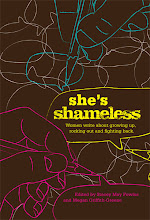Make sure to bring an assortment of heavy duty, extra strength deodorants in bar or spray form. Keep them at hand in case of increased heat or physical activity, like group hugs, spontaneous pokemon tournaments or intense glomping. Remember, posing for photos can be strenuous, especially when your prop is as tall as you are.
 You are bound to sweat so wearing another layer underneath your costume will conveniently soak up excess moisture. Donning a thin undershirt will prevent drenching your homemade duds as you compete in LARP tournaments, battle fellow fans to reach a rare anime series on sale in the Dealers Room, or flail your limbs wildly at the outdoor rave.
You are bound to sweat so wearing another layer underneath your costume will conveniently soak up excess moisture. Donning a thin undershirt will prevent drenching your homemade duds as you compete in LARP tournaments, battle fellow fans to reach a rare anime series on sale in the Dealers Room, or flail your limbs wildly at the outdoor rave.Step two: Become one with the costume.
You didn’t spend countless late nights stitching by the glow of your Wii console to look like a schmuck at the convention, so make sure you can rock your threads. Details are everything. Take the time to double check your costume for any missing elements because you’re only as valuable as the authenticity of your footwear, gear and make-up. Bring extra supplies along in the devastating event that a face smearing mishap occurs or your key sword is damaged in an overenthusiastic run in with the heartless.
Getting hot in that mask? Removing it will spell your failure. If one con girl spies you looking more like you than your character then you can wave goodbye to epic, fantasy themed sex. No girl will bestow those memorized lines of undying love from your favourite series if you aren’t 100% legit.
 Step three: Try to have some class. This time.
Step three: Try to have some class. This time.If you see a sexy Kairi or Riku walk by with their tits popping out of their tops, avoid openly staring and stalking them for the remainder of the weekend. If you get excited, try to hide it and momentarily distract yourself by looking at the guy in the skin tight team rocket costume. If you do happen to get in close proximity with a hottie aim your sights on her face instead of her rack and prevent a nasty reaction.
 In reality a woman can still go Love Hina on your ass and slug you into the parking lot if she thinks you’re a jerk. There is still time to seduce her into your hotel room and play out scenes from your cherished final episodes, but you’re never going to get there if you’re too obvious. You may look like a sex-starved Otaku, but try not to act like one.
In reality a woman can still go Love Hina on your ass and slug you into the parking lot if she thinks you’re a jerk. There is still time to seduce her into your hotel room and play out scenes from your cherished final episodes, but you’re never going to get there if you’re too obvious. You may look like a sex-starved Otaku, but try not to act like one.Back to Reality.
If these tips seem likely to guarantee nabbing a con girlfriend then there is something seriously wrong with today’s anime obsessed youth. At my first Anime North convention on May 23rd I sat in on the latter half of a panel discussion literally called “How To Get a Con Girlfriend.” With the exception of step three (which I had to throw in) this was a sample of the types of suggestions doled out by a panel to a group of guys. It was a very strange and enlightening lesson in male cosplaying culture.
A guy dressed as Master Roshi from Dragon Ball Z actually enquired about how to avoid odours offensive to the opposite sex while travelling around with a giant turtle shell strapped to his back. Despite the fact that B.O. was as thick as smog in high traffic areas of the convention body odour should be the least of a guy’s worries. How about….oh I don’t know….just act naturally and talk to women?
 Another guy wanted to know how to not appear desperate when meeting women at the convention and relayed that con women he meets tend to be more desperate than he is, proven by the fact that he was able to “miraculously” have sex with one. This line of thought just made me sorry for the entire room…especially when this story was met with wild applause, cheering and one excited male who rushed over and high-fived the guy for his apparent achievement. He wasn’t even bad looking, but obviously thought that he wasn’t worth much, if a girl fucking a guy who writes fan fiction is miraculous.
Another guy wanted to know how to not appear desperate when meeting women at the convention and relayed that con women he meets tend to be more desperate than he is, proven by the fact that he was able to “miraculously” have sex with one. This line of thought just made me sorry for the entire room…especially when this story was met with wild applause, cheering and one excited male who rushed over and high-fived the guy for his apparent achievement. He wasn’t even bad looking, but obviously thought that he wasn’t worth much, if a girl fucking a guy who writes fan fiction is miraculous. What I got out of this discussion was a glimpse into the insecurities men may feel because their interests don’t adhere to mainstream male gender constructed pastimes of competitive sports, per se.
What I got out of this discussion was a glimpse into the insecurities men may feel because their interests don’t adhere to mainstream male gender constructed pastimes of competitive sports, per se.Men who enjoy anime culture are not hideous mutants that repel every woman they see. The fact that some guys who are so absorbed in anime can feel that way indicates to me that they struggle with their self esteem. The panel resembled a grade three classroom where boys assumed girls were foreign creatures and unattainable due to their strange taste for cartoons.


 “I absolutely love fucking you!” exclaims
“I absolutely love fucking you!” exclaims  “We’re making waves in feminism one orgasm at a time,’ she says, wrapping up her acceptance speech.
“We’re making waves in feminism one orgasm at a time,’ she says, wrapping up her acceptance speech. In a brief clip from the Crash Pad Series 2 – Unlocked, winner of the steamiest trans scene, we see a woman in a black bra and panties whimpering as the tattooed woman on top of her bites her neck, pushes her down into the bed sheets and smacks her ass. The once rambunctious church is silent, save the occasional randy yell of approval. When the scene ends the audience erupts into cheering. The temperature has definitely raised a few notches.
In a brief clip from the Crash Pad Series 2 – Unlocked, winner of the steamiest trans scene, we see a woman in a black bra and panties whimpering as the tattooed woman on top of her bites her neck, pushes her down into the bed sheets and smacks her ass. The once rambunctious church is silent, save the occasional randy yell of approval. When the scene ends the audience erupts into cheering. The temperature has definitely raised a few notches. The diverse male posse, Boylesque, delivers the awards on stage tonight, donning old school ties, suspenders, collared shirts and hats. “The more clips we present the more naked they get,” announces Deb Pearce, our host of the evening, with a blonde mullet and a flashy belt buckle.
The diverse male posse, Boylesque, delivers the awards on stage tonight, donning old school ties, suspenders, collared shirts and hats. “The more clips we present the more naked they get,” announces Deb Pearce, our host of the evening, with a blonde mullet and a flashy belt buckle. Next,
Next,  With a white rose amidst a bob of curls framing her heart-shaped face, Courtney Trouble, owner of
With a white rose amidst a bob of curls framing her heart-shaped face, Courtney Trouble, owner of  Next the male and female heart throbs of the year are announced. Tyler Knight, an actor whose chocolate brown member is stroked two-handedly on screen is not present, but the spiky haired brunette, Dylan Ryan, gasps wide eyed with her hands clasped over her lips at the announcement. She accepts the awards after we glimpse a clip of her climaxing. “I’m completely honored,” she says and pauses, biting her lip. “This is an incredible business to be in, I’m very lucky and I’m very happy that you like the work that I do.”
Next the male and female heart throbs of the year are announced. Tyler Knight, an actor whose chocolate brown member is stroked two-handedly on screen is not present, but the spiky haired brunette, Dylan Ryan, gasps wide eyed with her hands clasped over her lips at the announcement. She accepts the awards after we glimpse a clip of her climaxing. “I’m completely honored,” she says and pauses, biting her lip. “This is an incredible business to be in, I’m very lucky and I’m very happy that you like the work that I do.”  Alison Lee, the head organizer of the awards files on stage alongside the entire Good for Her crew to recognize their efforts. “Isn’t it fun showing porn in a church?” says Carlyle Jansen, in a corset and black shirt, while handing bouquets to the sex shop employees.
Alison Lee, the head organizer of the awards files on stage alongside the entire Good for Her crew to recognize their efforts. “Isn’t it fun showing porn in a church?” says Carlyle Jansen, in a corset and black shirt, while handing bouquets to the sex shop employees. By now the butt plug delivery boys have stripped down to their briefs and Young gets on her hands and knees to hunt among the boy’s prominent packages for her second award of the night, indie porn pioneer of the year. She wanks off a man in yellow who’s bent forward, holding the prize above his ass, out of her sight. The audience is cracking up and someone yells, “I don’t think you’re going to find it in there.”
By now the butt plug delivery boys have stripped down to their briefs and Young gets on her hands and knees to hunt among the boy’s prominent packages for her second award of the night, indie porn pioneer of the year. She wanks off a man in yellow who’s bent forward, holding the prize above his ass, out of her sight. The audience is cracking up and someone yells, “I don’t think you’re going to find it in there.”  “This is who I am. This is part of my art, of breathing,” says Young, after finally securing her award. We watch a clip of her being led with a chain around her neck by her then blonde-haired master, Ryan, who wears black platform stilettos. “I am so sick of seeing BDSM compared to torture. I’m really trying to destroy those stigmas,” Young says in a rush, her voice rising.
“This is who I am. This is part of my art, of breathing,” says Young, after finally securing her award. We watch a clip of her being led with a chain around her neck by her then blonde-haired master, Ryan, who wears black platform stilettos. “I am so sick of seeing BDSM compared to torture. I’m really trying to destroy those stigmas,” Young says in a rush, her voice rising. *As published in
*As published in 
 She leans forward, elbows resting on her knees, her pale blonde hair short and textured. “We’re looking at doing the least amount of self defence possible to run away,” she said, hands clasped, eyes fixed on each of us intently. “That’s what this is all about. I hope I never have to do this but these are some tools that I have in my tool box.”
She leans forward, elbows resting on her knees, her pale blonde hair short and textured. “We’re looking at doing the least amount of self defence possible to run away,” she said, hands clasped, eyes fixed on each of us intently. “That’s what this is all about. I hope I never have to do this but these are some tools that I have in my tool box.” Chard explains that when womanized men experience sexual assault in prison it indicates the reality of rape power dynamics over a group. Suggesting that low cut prison outfits instigate rape is ridiculous. If we can understand this about men, why can’t we understand it about women?
Chard explains that when womanized men experience sexual assault in prison it indicates the reality of rape power dynamics over a group. Suggesting that low cut prison outfits instigate rape is ridiculous. If we can understand this about men, why can’t we understand it about women? Handlarski’s dark, defined curls hang at the nape of her neck and she wears thin black glasses when she isn’t demonstrating attack defences. She instructs us to inhale and exhale while executing defensive attacks, saying “hut.” The “h” breath opens up the diaphragm ending with a “t” sound that prevents us from biting our tongues.
Handlarski’s dark, defined curls hang at the nape of her neck and she wears thin black glasses when she isn’t demonstrating attack defences. She instructs us to inhale and exhale while executing defensive attacks, saying “hut.” The “h” breath opens up the diaphragm ending with a “t” sound that prevents us from biting our tongues. Handlarski gestures to the white calligraphy on her black tank top representing the Wen-Do symbol. In the centre is the Japanese character for “woman” surrounded by a circle, which she calls the line of justice. Women need to trust their instincts and give themselves permission to act, which can also mean escaping a dangerous situation. “I want you to believe you’re worth defending,” Handlarski said, looking around the circle at us.
Handlarski gestures to the white calligraphy on her black tank top representing the Wen-Do symbol. In the centre is the Japanese character for “woman” surrounded by a circle, which she calls the line of justice. Women need to trust their instincts and give themselves permission to act, which can also mean escaping a dangerous situation. “I want you to believe you’re worth defending,” Handlarski said, looking around the circle at us.






















